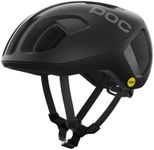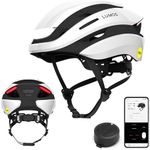Buying Guide for the Best Mips Bike Helmets
Choosing the right MIPS bike helmet is crucial for ensuring your safety while cycling. MIPS stands for Multi-directional Impact Protection System, which is designed to reduce rotational forces on the brain during angled impacts. When selecting a MIPS bike helmet, it's important to consider several key specifications to find the best fit for your needs. Here are the key specs and what you should know about them:Fit and SizeThe fit and size of a helmet are crucial for comfort and safety. A helmet that is too loose can move around and not provide adequate protection, while one that is too tight can be uncomfortable and cause headaches. Helmets typically come in small, medium, and large sizes, but it's important to measure the circumference of your head and consult the manufacturer's sizing chart. Look for adjustable fit systems, such as dial-adjust mechanisms, to fine-tune the fit.
VentilationVentilation refers to the number and size of vents in the helmet, which help keep your head cool by allowing air to flow through. This is especially important for long rides or hot weather. Helmets with more vents generally provide better airflow but may be less aerodynamic. Consider your typical riding conditions: if you ride in hot climates or do intense cycling, prioritize helmets with good ventilation.
WeightThe weight of a helmet can affect your comfort, especially on long rides. Lighter helmets are generally more comfortable and less fatiguing. Helmets can range from very lightweight models designed for racing to slightly heavier ones that offer more features or protection. If you plan on long-distance cycling or racing, a lighter helmet might be preferable.
Safety CertificationsSafety certifications indicate that the helmet has passed certain safety standards. Common certifications include CPSC (Consumer Product Safety Commission) for the US, CE (Conformité Européenne) for Europe, and AS/NZS for Australia and New Zealand. Ensure that the helmet you choose meets the safety standards relevant to your region. This ensures that the helmet has been tested for impact protection and other safety features.
AdjustabilityAdjustability features, such as straps and retention systems, help you achieve a secure and comfortable fit. Look for helmets with easily adjustable straps and a retention system that can be fine-tuned to your head shape. This is important for ensuring that the helmet stays in place during a crash and provides the best protection.
VisibilityVisibility features, such as bright colors and reflective elements, can enhance your safety by making you more visible to motorists and other cyclists. If you often ride in low-light conditions or busy traffic, consider a helmet with high-visibility colors or built-in lights. This can significantly improve your safety on the road.
Comfort FeaturesComfort features, such as padding and moisture-wicking liners, can make a big difference in how enjoyable your ride is. Look for helmets with removable and washable pads, as well as liners that wick away sweat. These features are particularly important if you ride frequently or for long durations, as they help keep you comfortable and dry.














